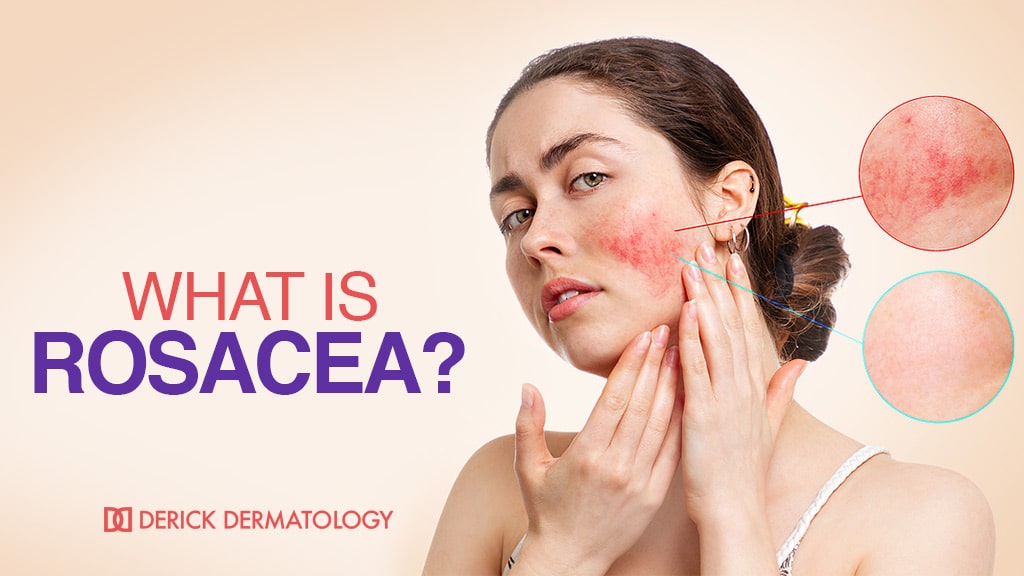What is Rosacea?
Rosacea is a skin condition that affects about 14 million people each year. While it is more common in middle-aged women who are going through menopause, men can develop the condition too, especially if they have a light-skinned complexion. Because of this, understanding what is rosacea requires learning the types of the condition, the symptoms that they can each cause, and what some of the current treatment options are.
Types of Rosacea
These are the four most common types of rosacea:
1. Prerosacea
Prerosacea is the first stage of this skin condition. During this time, affected individuals will notice that they have a flushed appearance to their skin that isn’t related to embarrassment, overexertion, or hot weather.
2. Vascular Rosacea
As the skin condition further develops, it will be easier to notice blood vessels in the face. Since women are affected by rosacea more often than men, it is more common for them to notice that their cheeks look fuller from facial swelling. Their skin will also feel warm to the touch.
3. Inflammatory Rosacea
While inflammatory rosacea is not the same as regular acne, it can sometimes affect the skin in a similar way. Regular acne is caused by clogged pores though, so dermatologists check for the appearance of blood vessels on the face to ensure that their patients are diagnosed properly.
4. Rhinophyma
Left untreated, rosacea can cause the development of rhinophyma, which is an enlargement of the nose. Men seem to be affected by rhinophyma more than women. Symptoms of this condition include redness and swelling of the nose and oily skin.
Other Common Symptoms That Occur With Rosacea
While each stage of rosacea has its own set of symptoms, doctors often check for other medical conditions that might be present because this will help ensure that they have the right diagnosis. In order to do this, they often take a look at the eyes. While an eye examination might sound strange for a skin condition, it is necessary because rosacea contributes to eye redness, burning, and itching. It is also common for people to feel as if they have something stuck in their eye when there is nothing present. The eyelids will be examined as well, because rosacea will often make them look a bit swollen.
Rosacea Treatments That Are Available
Like any other health condition, the treatment method that is used for rosacea will be determined based on a person’s current health status and what stage of the illness that they have. Dermatologists also need to know if a person has any allergies or skin conditions that they are being treated for. After learning this information, they will choose one of the following treatment options that are available:
1. Azelaic Acid
One topical cream that has been proven to treat rosacea is azelaic acid. This prescription medication is often very helpful because it is effective for reducing the symptoms of both rosacea and acne vulgaris. In order to apply the foam to the skin, all a person has to do is shake the can and gently rub it over the affected areas. The side effects from it can include redness and burning. Also, during treatment, patients must avoid alcohol, spicy food, and anything that could aggravate their skin condition.
2. Light Therapy
Intense light therapy, which is also called phototherapy, involves the use of pulsing lasers that are directed at the affected areas of the skin. This treatment has been shown to be especially helpful for reducing the appearance of unsightly blood vessels on the skin.
3. Antibiotics and Other Oral Prescription Medications
Numerous medications have been approved for rosacea, such as clindamycin, erythromycin, minocycline, and carvedilol. Some of them work to reduce severe redness. Others are helpful for fighting acne. In severe types of rosacea, isotretinoin might be the only effective treatment that can help alleviate symptoms. But doctors use caution when prescribing it to pregnant women because it can lead to birth defects in their unborn child and other serious side effects.
4. Electrosurgery
Electrosurgery is one of the most evasive treatment options that are available for rosacea. That is why it is mostly reserved only for treating the last stage of the condition, rhinophyma. The way that it works is by trimming down the bulbous nose tissue with a thin wire that has electricity running through it. But it can also help remove severe skin growths. While electrosurgery is generally an outpatient procedure, it isn’t usually recommended for people who take blood thinners or have some type of bleeding disorder.
After reading the types, symptoms, and rosacea treatments that are available, some people may want to learn more about what is rosacea and how they can get help with a diagnosis. In order to do this, it is best to always check with a certified dermatologist who specializes in these and other skin conditions. And remember, never attempt to perform any medical procedures yourself because they could cause more harm than good.







